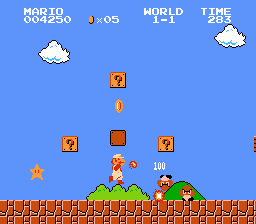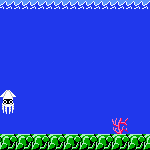The game is simple enough. I don't have to explain the mechanics, so I will get right into explaining the way enemy behavior attempts to challenge the player. Most enemies are simple: koopas (the turtles) and goombas walk in a line, some fall off ledges, others turn around. Simple enemy mechanics.
Some are not so simple.
One perfect example of this are the Bloopers, the squid enemies.
Excuse me, have you heard how squid has a plan for your life?
Bloopers are fascinating in terms of their behavior. Just like the red ghost in Pac-Man, they pursue the player relentlessly. The trick is their movement ability. They move erratically, by bumping up and then lowering slowly. It's possible to easily outrun the Blooper, though it's hard and they can be a little annoying. However, if you go under them it's a bit easier.
The fact that an enemy can feel real and hated is a perfect example of what good AI in games is supposed to do: simulate a predictable behavior.
Bloopers are predictable, and because of that they are feared and hated by Mario players. Players could be exposed to a Blooper's behavior and react accordingly to it. That's one of the most important aspects of Ai in video games: players are supposed to see what they see. That's just good AI.




No comments:
Post a Comment